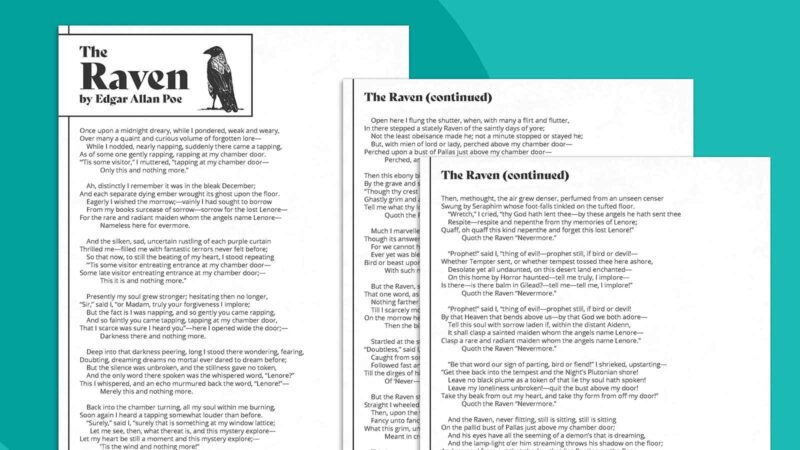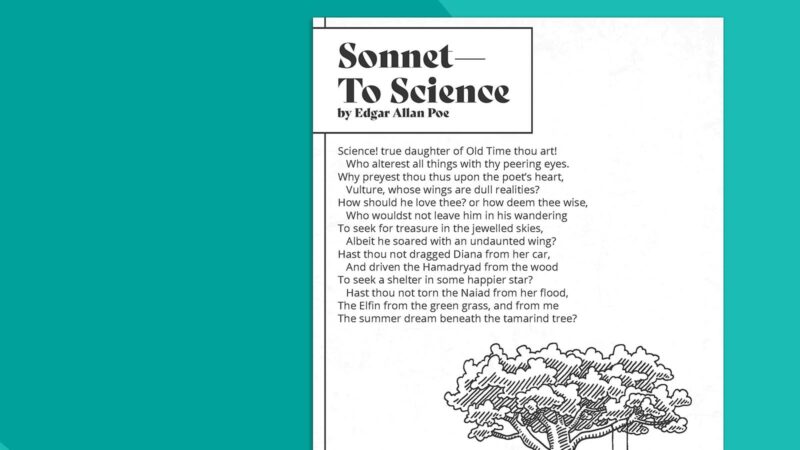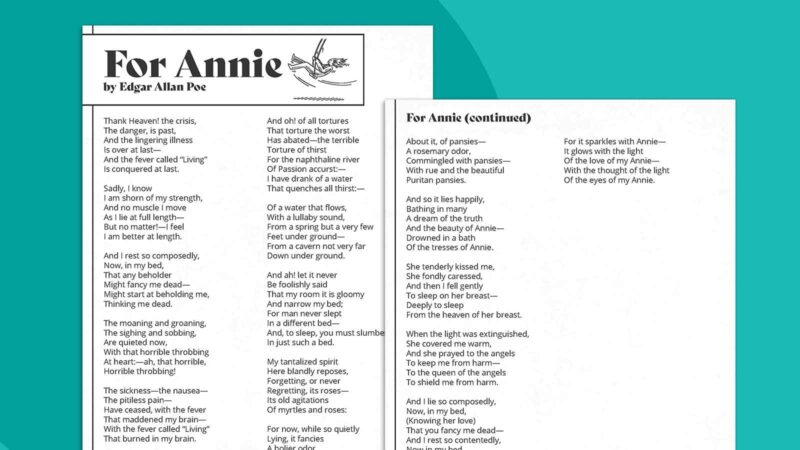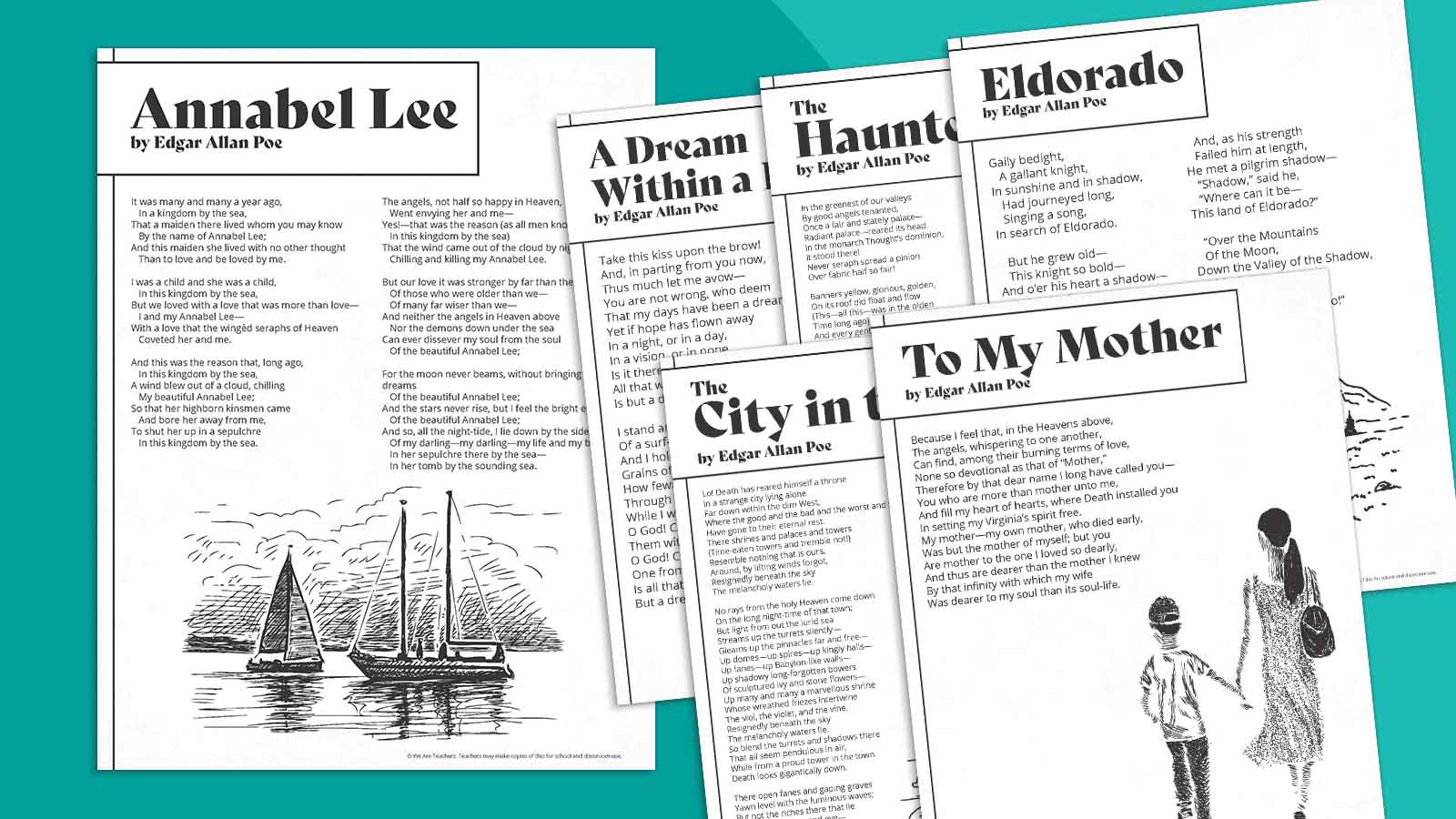Edgar Allan Poe was a prolific writer, known for a number of literary achievements. As a short-story writer, he was famous for his Romantic and Gothic fiction, as well as for innovations in science fiction, horror, and detective stories. But this genius wordsmith also loved to write poetry, penning more than 70 works of verse in his short life. These 25 Edgar Allan Poe poems are among his best, showing his mastery of language and literary devices.
Get the full text of each poem as a free printable to use with your students by filling out the form.
Yes, I Want My Free Printable Poems
The Raven
“Once upon a midnight dreary, while I pondered, weak and weary,
Over many a quaint and curious volume of forgotten lore—”

Published in 1845, toward the end of his life, “The Raven” is easily Poe’s most popular poem. The haunting rhyme and repetition throughout evoke an eerie mood that draws in even the most reluctant readers of poetry. Unlike some Edgar Allan Poe poems, this one uses accessible language that readers of all ages can understand and enjoy. Those who want to take a deeper dive will find allusions, poetic devices, and more that add further significance to these well-known verses.
Annabel Lee
“I was a child and she was a child,
In this kingdom by the sea,
But we loved with a love that was more than love—
I and my Annabel Lee—”
Poe wrote multiple poems about women, often those who had died tragically young. “Annabel Lee” is probably the most famous of these odes, written in simple but evocative language that seems to sing. This was the last full poem Poe wrote before his early death at age 40 in 1849.
The Bells
“To the tintinnabulation that so musically wells
From the bells, bells, bells, bells,
Bells, bells, bells—
From the jingling and the tinkling of the bells.”
From the light jingle of sleigh bells to the heavy toll of funeral bells, Poe explores the sounds and emotions of the eponymous noisemakers. The repetitive use of the word itself becomes progressively more crazed, until the reader can feel those bells ringing inside their own heads. This is a popular poem for teaching onomatopoeia, as well as how changes in meter can affect the overall feeling of a composition.
A Dream Within a Dream
“All that we see or seem
Is but a dream within a dream.”
It’s a thought that comes to many of us at one time or another: What if all of life is really just one long dream? A reference to “grains of the golden sand” evokes the image of an hourglass, with the precious seconds of life draining away relentlessly. The narrator vainly wishes to freeze time, keeping just one grain from “the pitiless wave,” but to no avail.
Sonnet—To Science
“Science! true daughter of Old Time thou art!
Who alterest all things with thy peering eyes.”

Like many poets, Poe worried that advances in science would remove a sense of mystery from the world. Scientists seek to answer questions the narrator feels are better left to the imagination, wishing to be left “in his wandering / to seek for treasure in jeweled skies.” Written as a traditional 14-line English sonnet, this poem includes several classical literary allusions that modern readers may need to research to fully understand their meaning.
The Haunted Palace
“But evil things, in robes of sorrow,
Assailed the monarch’s high estate;
(Ah, let us mourn!—for never morrow
Shall dawn upon him, desolate!)”
First written as a standalone poem, “The Haunted Palace” was later incorporated into Poe’s masterful short story “The Fall of the House of Usher.” When read as part of the larger work, this poem reflects the disordered mind of a man haunted by literal and emotional phantoms. The haunted palace itself is written as a metaphor, with two windows for eyes and the door an open mouth through which “a troop of Echoes” sing.
Eldorado
“‘Over the Mountains / Of the Moon,
Down the Valley of the Shadow,
Ride, boldly ride,’ / The shade replied,—
‘If you seek for Eldorado!’”
The legend of El Dorado, a mythical city made of gold, perpetuated throughout the settling of the Americas. This brief poem tracks the journeys of a knight who spends an entire lifetime in search of the storied treasure. As his life draws to a close, he asks a “pilgrim shadow” to point the way. The answer seems to indicate that death and the afterlife are the only place to find the true Eldorado.
The City in the Sea
“Lo! Death has reared himself a throne
In a strange city lying alone
Far down within the dim West …”
Inspired by works like Samuel Taylor Coleridge’s “Kubla Khan,” Poe wrote of a city in the West, ruled over by Death. It’s a perfect representation of the Gothic themes the author explored so well, personifying Death and imbuing it with human characteristics. Full of repetition and alliteration, “The City in the Sea” is one of many Edgar Allan Poe poems that demonstrate his masterful use of poetic devices.
To Helen
“Helen, thy beauty is to me
Like those Nicéan barks of yore …”
Poe actually wrote this poem to woman named Jane Stanard, his first love. By calling her Helen, he compares her to Helen of Troy, fabled for her incredible beauty. At first reading, this poem may feel inaccessible to many modern readers unfamiliar with the classical allusions throughout. A little research into the names and references reveals the flattering similes and metaphors that describe the subject’s beauty and grace.
Lenore
“Ah broken is the golden bowl! the spirit flown forever!
Let the bell toll!—a saintly soul floats on the Stygian river …”

In this ode, Poe uses the name “Lenore,” later found in “The Raven.” This poem came earlier, and tells the story of her lover, Guy De Vere, who chooses to mourn her in his own way. While others want the traditional mournful funereal dirge, the narrator instead proposes a celebration of her passage to paradise. Note the emphasis on the letter “L” throughout, a common device in Poe’s poetry.
Alone
“From childhood’s hour I have not been
As others were—I have not seen
As others saw—”
Written when Poe was just 20 years old, this poem reflects on his sense of being different than others. It’s bound to resound with many teens, who often believe that they’re alone, with no one who understands how they think or feel. Poe’s descriptions of isolation and inner torment may sound overwrought to some, while others see themselves represented in his revealing words.
Ulalume
“It was night in the lonesome October
Of my most immemorial year …”
It’s interesting to note that Poe wrote this poem specifically as an elocution piece, which means it was written to be spoken aloud. It’s best read that way even today, noting the emphasis on sound and rhythm. This is another poem full of literary allusions, meaning a little research can help the modern reader make a deeper connection to Poe’s meaning in this lament for lost love.
Silence
“There is a two-fold Silence—sea and shore—
Body and soul.”
This enigmatic sonnet hasn’t been the subject of nearly as much analysis as some Edgar Allan Poe poems. That makes it an excellent subject for students looking to explore Poe from a new angle, giving their own interpretation to this challenging piece of work. Compare the possible impacts of silence on different people in different situations, considering how it can be a soothing balm—or quiet torture.
Dream-Land
“For the heart whose woes are legion
’T is a peaceful, soothing region—
For the spirit that walks in shadow
’T is—oh, ’t is an Eldorado!”
With nearly identical first and last stanzas, this poem describes a place “out of space—out of time.” The narrator details his surroundings and concludes he has “wandered home.” The Dream-Land itself is often considered to be death or the afterlife, a welcoming yet strange place that all travelers must eventually visit.
For Annie
“And the lingering illness
Is over at last—
And the fever called ‘Living’
Is conquered at last.”

Poe himself considered this longer poem one of the finest he had ever written. The subject, Nancy Richmond, was a woman with whom he had a complicated relationship, platonic but very deep. She supported him through a challenging mental crisis, helping him find a sense of peace and purpose near the end of his life.
The Conqueror Worm
“Out—out are the lights—out all!
And, over each quivering form,
The curtain, a funeral pall,
Comes down with the rush of a storm …”
Originally published on its own, Poe later used “The Conqueror Worm” in his short story “Ligeia.” An audience of weeping angels watches a play unfold in which mimes, “mere puppets,” run about randomly but persistently chasing a “Phantom.” The play ends when “the Conqueror Worm” of Death arrives, putting an end to the tragedy of Man’s life, represented by the mimes. It’s a solemn reflection on the author’s perceived futility of life and the inevitability of death.
To My Mother
“My mother—my own mother, who died early,
Was but the mother of myself; but you
Are mother to the one I loved so dearly,
And thus are dearer than the mother I knew …”
Poe’s own mother died when he was very young, and his father abandoned the family. Edgar was raised by a foster family, but he connected most strongly with his mother-in-law, Maria Clemm. This ode to her will resonate with anyone who feels that a chosen family is just as important (if not more) as the family you’re born into.
Evening Star
“And more I admire
Thy distant fire,
Than that colder, lowly light.”
The narrator of this lyric poem finds the moon bright and beautiful but cold and distant. Instead, he admires the evening star, which seems to shine just for him. Poe celebrates the splendor of nature, and perhaps intends it as a metaphor on various types of human relationships.
Dreams
“Oh! that my young life were a lasting dream!
My spirit not awakening, till the beam
Of an Eternity should bring the morrow.”
This is one of several Edgar Allan Poe poems about dreams, a theme he returned to again and again. Here, he posits that the happiness of dreams is better than the waking reality. Written in rhyming couplets, the poem and its poet yearn for happy childhood days, which the narrator can only find in his dreams.
Eulalie
“I dwelt alone / In a world of moan
And my soul was a stagnant tide
Till the fair and gentle Eulalie
became my blushing bride—”
Once again, Poe writes of a beautiful woman whose life was cut short, lamenting her loss but celebrating her days. The narrator praises Eulalie for rescuing him from a sad and lonely life, noting that even though she is now gone, she has left him a better person for knowing her. The optimistic tone of the final stanza is in sharp contrast to the funereal feel of many of Poe’s other odes to lovers lost.
The Sleeper
“At midnight, in the month of June,
I stand beneath the mystic moon.”
Poe considered this one of his best poems, writing to a friend that it was even better than “The Raven” (though he knew most would disagree). The narrator begins by describing a lovely nighttime scene, filled with flowers and moonlight. But soon the deeper meaning bleeds in, as the reader realizes the narrator stands in a cemetery, watching a grave being prepared for a woman who has died. The rest of the poem describes the deceased, hoping she now sleeps in peace.
An Acrostic
“Elizabeth it is in vain you say
‘Love not’—thou sayest it in so sweet a way …”
An acrostic, in which each line of a poem begins with the letter of a word (which is often used as the title) is one of the earliest poetic forms many kids learn. They may be surprised to see accomplished poets like Poe used this form too. This verse, spelling out Elizabeth, was written for one of Poe’s cousins. Unpublished until long after Poe’s death, this is actually one of his earliest known works, written in 1829.
To One in Paradise
“Ah, dream too bright to last!
Ah, starry Hope! that didst arise
But to be overcast!”
You’ll find many of Poe’s common themes in this poem: death, the loss of a loved one, dreams, sorrow and depression, and more. Loss has plunged the narrator into the deepest despair, and ultimately, he feels he can only be happy now when he retreats into his dreams. Many consider this one of Poe’s finer works.
Tamerlane
“I have no words—alas!—to tell
The loveliness of loving well!”

This is one of the longest Edgar Allan Poe poems, telling the fictionalized story of a Turco-Mongol conqueror. The hero sacrifices love for power, ultimately lamenting his choice on his deathbed. Poe himself may have identified with Tamerlane, as he used the name as a pseudonym several times.
Epigram for Wall Street
“I’ll tell you a plan for gaining wealth,
Better than banking, trade or leases—
Take a bank note and fold it up,
And then you will find your money in creases!”
Short and witty, this anonymously published poem is commonly believed to have been written by Poe. Though there’s some debate over the authorship, the clever use of language is certainly well within Poe’s abilities, although quite different from his usual style. It’s a fun read, full of puns and word play, and bound to be a surprise to students used to Poe’s drearier works.
Get free printables of all the poems
Just share your email address for instant access to full-text printable versions of all the Edgar Allan Poe poems on this list.


